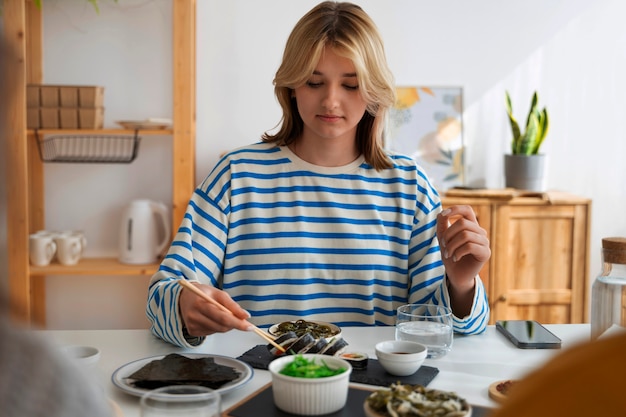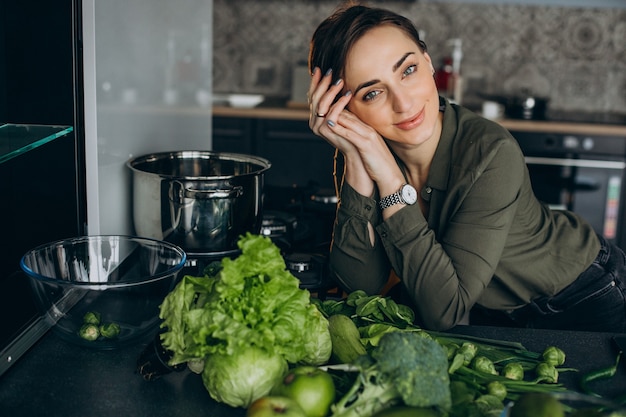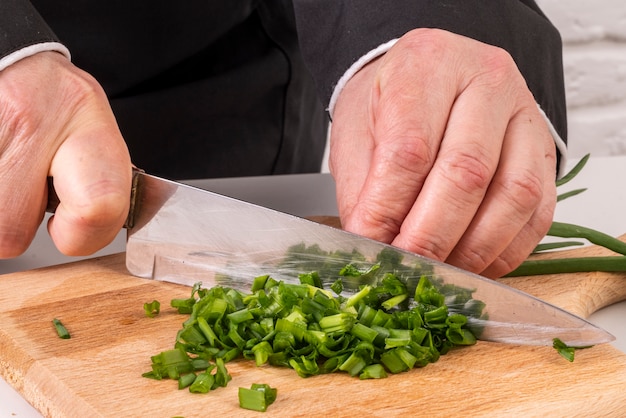Ah, collard greens. A staple in many Southern kitchens, and a personal favourite of mine. I remember growing up, the aroma of simmering collard greens filling the house, a comforting sign that a hearty, wholesome meal was on its way. But let's be honest, collard greens can be a bit of a mystery. How long do you cook them? What's the secret to getting them just right? Well, my friends, fret no more, because I'm about to share my tried and true methods for achieving perfectly tender, flavourful collard greens every single time.
(Part 1) The Art of Choosing the Right Collard Greens

First things first, you've got to start with the right greens. A good batch of collards will make all the difference in the world. Think of it like this: you wouldn't try to bake a cake with stale flour, would you? No way! You need fresh, vibrant ingredients, and that goes double for your collards. Here's what to look for:
Looking for Freshness
I always go for collards with deep green leaves that are free of any brown spots or wilting. They should be firm to the touch, not limp or soft. Imagine picking out a bunch of grapes - you wouldn't want one that feels squishy, right? The same principle applies to your greens. A good way to check is to gently press a finger into the leaf - it should spring back slightly.
Size Matters
Now, you'll find collard greens in different sizes. Some are petite, others are big and bold. I personally love the larger leaves. They give you more surface area for all that delicious flavour to soak in. But hey, if you prefer smaller leaves, go for it! It's all about personal preference.
Storage is Key
Once you've got your perfect bunch of collard greens, you've got to store them right. I like to wrap them loosely in a paper towel and then pop them in a plastic bag. This helps to prevent them from drying out and keeps them fresh for a few days. Avoid storing them in direct sunlight or heat, as this can cause them to wilt quickly.
(Part 2) The Prep Work: Getting Ready to Cook

Alright, you've got your greens, now it's time to get down to business. Prep work is key. Just like with anything else, a little bit of effort up front makes a big difference in the end result. Here's what I do:
Cleaning Your Greens
I always give my collard greens a good wash. You never know what kind of critters might have been hanging out on them. I like to fill a big bowl with cold water and swish the leaves around a bit. Then, I give them a good rinse under the tap. You can even soak them in a bowl of water with a splash of white vinegar to remove any pesky bugs or grit. A final rinse in clean water ensures they're ready for the next step.
Trimming the Leaves
Next, it's time to trim those leaves. I usually cut off the tough stems and any damaged or discoloured bits. It's not a big deal if you leave a little bit of stem on, but too much can make the greens tough and unpleasant to eat. Think of it as giving your greens a nice haircut. A sharp knife is the best tool for the job, but you can also use kitchen shears for a quicker trim.
Chopping Those Leaves
Now, here's where things get interesting. I like to chop my collard greens into bite-sized pieces. You can chop them roughly or finely, depending on your preference. I find that chopping them into strips gives them a nice texture and allows the flavour to permeate evenly. If you're looking for a smoother texture, you can also use a food processor to chop the leaves.
(Part 3) Mastering the Art of Cooking Time

Okay, you've prepped your greens, now it's time for the real magic - cooking them to perfection. This is where the fun begins. Remember, the goal is to achieve tender, succulent greens that are bursting with flavour. Here's how I get it done:
The Importance of Boiling
I start by boiling my collard greens. I add them to a large pot of boiling water and let them cook for about 5-10 minutes, or until they're slightly softened. This helps to break down the tough fibers and makes them easier to digest. It's like giving them a nice, relaxing steam bath. Make sure the water is at a rolling boil before adding the greens. This ensures they cook evenly and retain their vibrant colour.
Simmering to Perfection
Once the greens are slightly softened, I drain them and transfer them to a large pot with a little bit of water or broth. Now, this is where the real magic happens. I simmer the greens over low heat, covered, for about 30-45 minutes, or until they're tender and the leaves have shrunk by about half. This is the key to unlocking that deep, rich flavour that I absolutely adore. It's like letting them slowly bathe in a flavourful broth. For a richer flavour, try using a good quality vegetable broth instead of water.
The Secret to Avoiding Overcooking
One thing I've learned over the years is that it's important not to overcook your greens. Overcooked collard greens can become mushy and lose their flavour. Think of them like a delicate flower - you wouldn't want to crush it, would you? The same goes for your greens. They need a little bit of TLC. I always check for tenderness by gently pulling a leaf apart with a fork. If it tears easily, they're ready. If it still feels tough, give them a few more minutes. Overcooked collards can also turn a dull, greyish colour, so keep an eye on the colour as they cook.
(Part 4) Adding Flavor: The Recipe for Success
You've got your perfectly cooked greens. Now it's time to take things to the next level. Flavour is everything! Here's where you can really get creative and experiment with different combinations. But, here are a few of my go-to ingredients that never fail to elevate my collard greens to another level:
The Power of Smoked Meat
Okay, let's talk about smoked meat. For me, there's nothing quite like a good dose of smoked turkey or ham to give my collard greens that smoky, savory kick. I usually add a few chunks of smoked meat to my pot of simmering greens, and let it all meld together for that extra oomph. It's like adding a touch of luxury to your meal. You can also use smoked bacon or even smoked sausage for a similar effect. Just make sure to remove any excess fat before adding it to the pot.
The Magic of Onions and Garlic
Now, you can't go wrong with a good amount of onions and garlic. They add a sweetness and depth of flavour that really elevates your greens. I usually sauté some chopped onions and garlic in a little bit of oil before adding my greens to the pot. It's like adding a little bit of sunshine to your dish. You can use any type of onion, but I find that yellow onions have a good balance of sweetness and sharpness. For garlic, use fresh cloves for the best flavour.
The Versatility of Seasoning
Now, when it comes to seasoning, the sky is the limit! I like to keep things simple with a good amount of salt and pepper. But, you can also get creative and add other seasonings like smoked paprika, cayenne pepper, or even a touch of cumin. It's all about finding what works best for your taste buds. If you're feeling adventurous, try adding a pinch of red pepper flakes for a subtle kick.
Adding a Little Bit of Acid
Here's a little trick I've learned over the years. A little bit of acid can really brighten up the flavour of your greens. I like to add a splash of apple cider vinegar or lemon juice to my pot of simmering greens. It just adds a little bit of zing that takes things to the next level. You can also try adding a pinch of sugar to balance out the acidity. The key is to add a little at a time and taste as you go to ensure the flavour is perfectly balanced.
(Part 5) Serving Your Collard Green Masterpiece
So, you've cooked your greens to perfection. You've seasoned them to your liking. Now it's time to serve them up! There are so many delicious ways to enjoy your collard greens, and it all comes down to your personal preference. Here are a few of my favourites:
Traditional Southern Style
My go-to way to serve collard greens is in the classic Southern style, alongside a big ol' plate of fried chicken, mashed potatoes, and gravy. It's a truly satisfying and comforting meal that's perfect for a cold winter's day. The rich flavour of the collards complements the crispy chicken and creamy mashed potatoes perfectly.
A side dish for Your Favourite Meals
Collard greens make a fantastic side dish for just about any meal. They're great with grilled meats, roasted vegetables, or even fish. I love serving them with a simple drizzle of olive oil and a sprinkle of salt and pepper. It's a light and refreshing way to enjoy them. They also pair well with hearty soups and stews.
A Creative culinary adventure
Don't be afraid to get creative with your collard greens. They can be used in all sorts of dishes, from soups and stews to salads and wraps. I've even used them to make a delicious collard green dip for my chips. The possibilities are endless! They can also be added to stir-fries for a boost of flavour and nutrition.
(Part 6) Collard Greens and Your Health: A Nutritious Delight
Let's face it, collard greens are not just delicious, they're also incredibly good for you. They're packed with vitamins, minerals, and antioxidants that can help boost your health and wellbeing. Here's what makes collard greens so special:
A Powerhouse of Vitamins and Minerals
Collard greens are a great source of vitamins A, C, and K, as well as folate, iron, and calcium. They're also a good source of fiber, which helps to keep you feeling full and satisfied. Plus, those antioxidants can help to protect your cells from damage and reduce your risk of chronic diseases. One cup of cooked collard greens provides about 10% of your daily vitamin C needs and a significant amount of vitamin A.
Fighting Off Disease
Studies have shown that a diet rich in leafy green vegetables like collard greens can help to reduce the risk of heart disease, stroke, and some types of cancer. That's a powerful reason to add them to your regular menu. The high fiber content in collards helps lower cholesterol levels, while the antioxidants can help protect against cell damage.
A Boost for Your Skin and Hair
Collard greens are also great for your skin and hair. The vitamins and minerals in collard greens can help to promote healthy skin and hair growth. So, if you're looking for a natural way to boost your beauty, add some collard greens to your diet. The vitamin C in collard greens helps to produce collagen, a protein that gives your skin its elasticity. The iron in collard greens helps to carry oxygen to your hair follicles, which can promote healthy hair growth.
(Part 7) FAQs: Your Collard Green Questions Answered
Now, I know you might have a few questions about collard greens. That's completely normal. I get asked all sorts of questions about them, from how to choose the best bunch to how long to cook them. So, let's tackle some of the most common questions:
1. What is the best way to store collard greens?
The best way to store collard greens is to wrap them loosely in a paper towel and then place them in a plastic bag. This helps to prevent them from drying out and keeps them fresh for a few days. You can also store them in the refrigerator crisper drawer for up to a week. If you want to store them for longer, you can freeze them after blanching them in boiling water for a few minutes.
2. How can I tell if collard greens are bad?
If your collard greens have brown spots, are slimy, or have a strong odor, they're probably bad. It's best to discard them and buy a fresh bunch. You can also check the leaves for any signs of mold or insects. If you see any, it's best to throw the greens away.
3. Can I freeze collard greens?
Yes, you can freeze collard greens! Simply blanch them in boiling water for a few minutes, then drain and cool them completely. Store them in freezer bags or containers for up to 3 months. Blanching helps to preserve the colour and texture of the greens. To blanch, simply immerse the greens in boiling water for 2-3 minutes, then plunge them into ice water to stop the cooking process.
4. Can I cook collard greens in the oven?
Yes, you can roast collard greens in the oven. Simply toss them with a little olive oil, salt, and pepper, and roast them at 400°F for about 20-25 minutes, or until they're tender and slightly crispy. Roasting brings out the natural sweetness of the greens and gives them a nice, crispy texture. You can also add other seasonings like garlic powder, onion powder, or red pepper flakes to your roasted collards.
5. How long can I store cooked collard greens?
Cooked collard greens can be stored in the refrigerator for up to 4 days. You can also freeze them for up to 3 months. Just be sure to cool them completely before freezing. To reheat frozen collard greens, simply thaw them in the refrigerator overnight and then reheat them in a saucepan over low heat. You can also reheat them in the microwave for a quicker option.
(Part 8) The Journey Continues: A Passion for Collard Greens
My love affair with collard greens goes way back. It's a love story that began with a simple plate of greens, cooked with love and passed down through generations. It's a love story that continues to unfold with every bite, every new flavour combination, every healthy benefit I discover. It's a love story that I hope you'll share with me, whether you're a seasoned collard green enthusiast or just starting to explore their delicious world.
So, go ahead, try my tips and tricks. Experiment with different recipes. And, most importantly, enjoy the journey. Collard greens are a gift, a culinary treasure waiting to be discovered. And, I have a feeling, you'll be amazed by what you find.
Everyone is watching

Prime Rib Roast Cooking Time Chart: Per Pound Guide
Cooking TipsPrime rib roast. Just the name conjures images of lavish dinners, crackling fires, and hearty laughter. It’s ...

How Long to Bake Potatoes in the Oven (Perfect Every Time)
Cooking TipsBaked potatoes are a staple in my kitchen. They're incredibly versatile, delicious, and surprisingly easy to m...

Perfect Rice Every Time: The Ultimate Guide to Cooking Rice
Cooking TipsAs a self-proclaimed foodie, I've always been a bit obsessed with rice. It's the foundation of countless cuisi...

The Ultimate Guide to Cooking Asparagus: Tips, Techniques, and Recipes
Cooking TipsAsparagus. The mere mention of this spring delicacy conjures up images of vibrant green spears, crisp and burs...

Ultimate Guide to Cooking the Perfect Thanksgiving Turkey
Cooking TipsThanksgiving. Just the word conjures up images of overflowing tables laden with delicious food, the scent of r...
